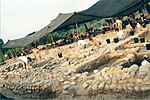Yarmukian culture
The Yarmukian Culture is a Neolithic culture of the ancient Levant. It was the first culture in Prehistoric Israel and one of the oldest in the Levant to make use of pottery. The Yarmukian derives its name from the Yarmouk River which flows near its type site at Sha'ar HaGolan, a kibbutz at the foot of the Golan Heights.

Sha'ar HaGolan
The first Yarmukian settlement was unearthed at Megiddo during the 1930s, but was not identified as a distinct Neolithic culture at the time. At Sha'ar HaGolan, in 1949, Prof. Moshe Stekelis first identified the Yarmukian Culture, a Pottery Neolithic culture that inhabited parts of Israel and Jordan.[1] The site, dated to ca. 6400–6000 BC (calibrated), is located in the central Jordan Valley, on the northern bank of the Yarmouk River. Its size is circa 20 hectares, making it one of the largest settlements in the world at that time. Although other Yarmukian sites have been identified since, Sha'ar HaGolan is the largest, probably indicating its role as the Yarmukian center.[2]
The site was excavated by two teams from the Hebrew University of Jerusalem: One led by Stekelis (1949–1952) and the other by Yosef Garfinkel (1989–90, 1996–2004). While during the earlier excavations no architecture was found, the second expedition uncovered large courtyard houses, ranging between 250 and 700 m² in area. The courtyard house makes its first appearance at Sha'ar HaGolan, giving the site a special significance in architectural history. This is an architectural concept still found among traditional Mediterranean societies. Monumental construction on this scale is unknown elsewhere during this period. The houses consist of a central courtyard surrounded by several small rooms.
The houses were separated by streets, which constitute evidence of advanced community planning. The dig uncovered a central street about 3 m wide, paved with pebbles set in mud, and a narrow winding alley 1 m wide. These are the earliest streets discovered in Israel and among the earliest streets built by man. A 4.15 m well dug to the local water table indicates a knowledge of hydraulics. Exotic objects discovered during the excavations include sea shells from the Mediterranean, polished stone vessels made of alabaster (or marble), and blades made from obsidian (volcanic glass) from Turkey. The presence of obsidian points to trade connections extending over 700 km.[2]
Pottery
The greatest technological innovation of the Sha'ar HaGolan Neolithic was the manufacture of pottery. This industry, which appears here for the first time in Israel, gives this cultural stage its name of Pottery Neolithic. The pottery vessels are in a variety of shapes and sizes and were put to various domestic uses.[1]
Art

About 300 art objects were found at Sha'ar HaGolan, making it the main center of prehistoric art in Israel and one of the most important in the world.[citation needed] One of the houses yielded approximately 70 figurines made of stone or fired clay. No other single building of the Neolithic period has yielded that many prehistoric figurines. Among the outstanding art objects from Sha'ar HaGolan are figurines in human form made of fired clay or carved on pebbles. The overwhelming majority are female images, interpreted as representing a goddess. The clay figurines are extravagant in their detail, giving them a surrealistic appearance, while the pebble figurines are minimalist and abstract in form. The members of Kibbutz Sha'ar HaGolan have built a museum that exhibits the finds from the nearby site.[2] Because of the unique artistic quality of the figurines from Sha'ar Hagolan, both the Metropolitan Museum of New York and the Louvre Museum in Paris have mounted ten-year exhibits of objects from the site. In Israel, figurines are exhibited at the Israel Museum in Jerusalem.
Related Sites
Besides the site at Sha'ar HaGolan, 20 other Yarmukian sites have been identified in Israel, Jordan and Lebanon.[2] These include:
- Tel Megiddo (Israel)
- Ain Ghazal (Jordan)
- Munhata (Israel)
- Tel Qishion (Israel)
- Hamadiya (Israel)
- Ain Rahub (Jordan)
- Abu Tawwab (Jordan)
Although the Yarmukian culture occupied limited regions of northern Israel and northern Jordan, Yarmukian pottery has been found elsewhere in the region, including the Habashan Street excavations in Tel-Aviv and as far north as Byblos, Lebanon.
Bibliography
- Stekelis M. 1972. The Yarmukian Culture. Jerusalem: Magnes Press.
- Garfinkel Y. 1993. The Yarmukian Culture in Israel. Paleorient, Vol 19, No. 1, pp. 115 – 134.
- Garfinkel Y. 1999. The Yarmukians, Neolithic Art from Sha'ar Hagolan. Jerusalem: Bible Lands Museum (Exhibition Catalogue).
- Garfinkel Y. and Miller M. 2002. Sha'ar Hagolan Vol 1. Neolithic Art in Context. Oxford: Oxbow.
- Garfinkel Y. 2004. The Goddess of Sha'ar Hagolan. Excavations at a Neolithic Site in Israel. Jerusalem: Israel Exploration Society (Hebrew version published in 2002 as: Sha'ar Hagolan. Neolithic Art in the Jordan Valley. Jerusalem: Israel Exploration Society).
- Garfinkel Y. and Ben Shlomo D. In press. Sha'ar Hagolan Vol. 2. Qedem. Jerusalem: Institute of Archaeology, Hebrew University.
- Garfinkel Y., Vered A. and Bar-Yosef O. 2006. The Domestication of Water: The Neolithic Well of Sha'ar Hagolan, Jordan Valley, Israel. Antiquity 80: 686–696.
- Obaidat Daifallah 1995. "Die neolithische Keramik aus Abu Thawwab/Jordanien". Berlin, ex Oriente.
Gallery
-
Sha'ar HaGolan, excavations 1998
-
Sha'ar HaGolan, flint arrowhead
-
Sha'ar HaGolan, flint axe
-
Sha'ar HaGolan, pottery
-
Sha'ar HaGolan, well
-
Sha'ar HaGolan, zoomorphic figurine
-
Sha'ar HaGolan, clay figurine
-
Sha'ar HaGolan, courtyard buildings








